Semester 1 2019 BUA5MFN: CS Energy Power Station Project Report
VerifiedAdded on 2022/12/15
|7
|2081
|323
Report
AI Summary
This report provides a comprehensive analysis of CS Energy's proposed nuclear power station investment project. It evaluates the project's financial viability through both quantitative and qualitative analyses. The quantitative analysis employs capital budgeting methods, calculating profitability levels, internal rate of return (IRR), payback period, and profitability index to assess the investment's potential returns and risks. The qualitative analysis examines factors such as electricity delivery, consumption, market position, and economic performance. The report also assesses associated risks, recommending whether the project should be undertaken by the company and whether the project would be beneficial for the government. The analysis includes cash flow analysis, net present value (NPV), and sensitivity analysis to determine the project's financial attractiveness. The report concludes with a recommendation to accept the proposal based on the overall positive financial and operational outlook, while also acknowledging potential risks like nuclear reaction safety protocols.
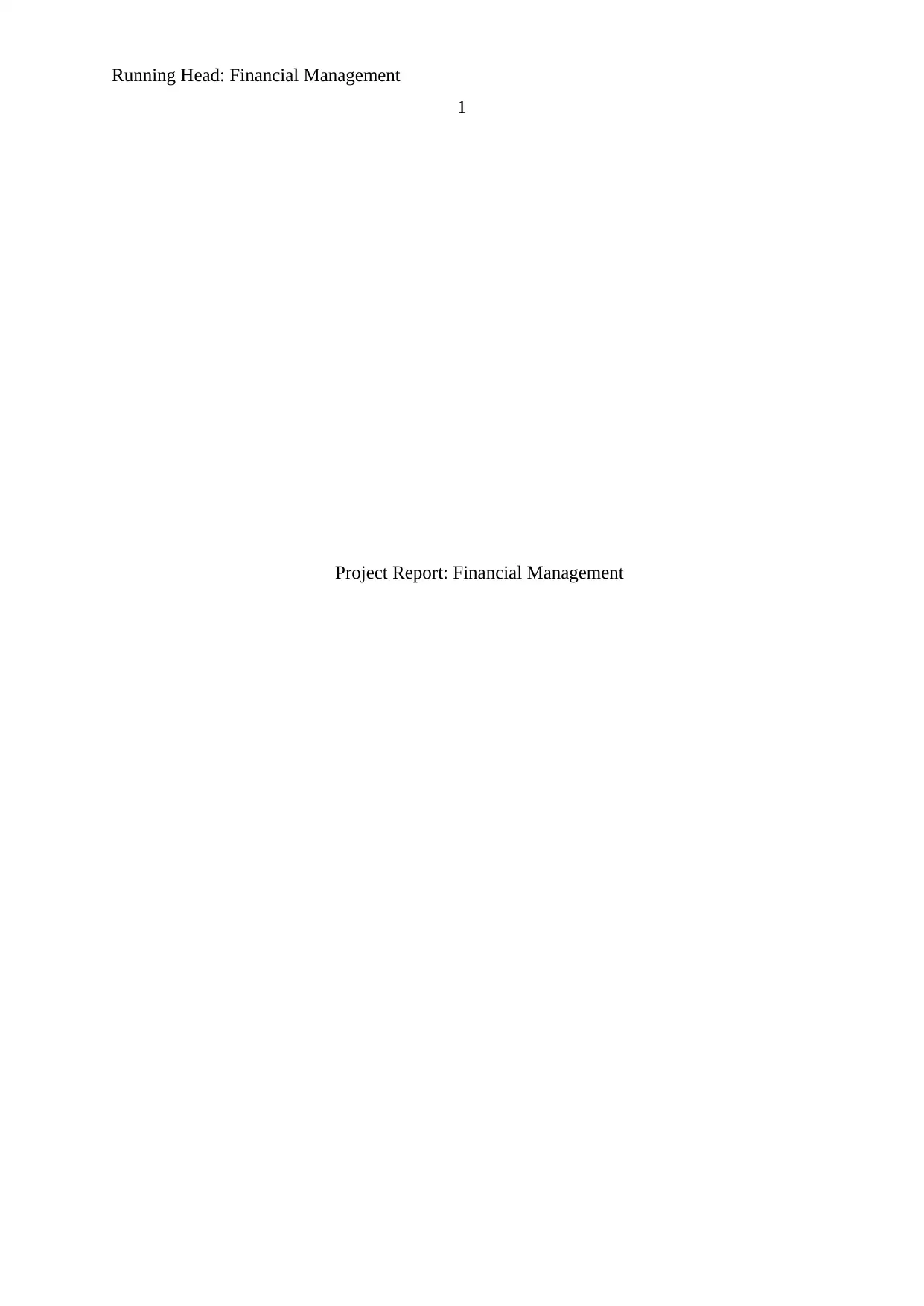
Running Head: Financial Management
1
Project Report: Financial Management
1
Project Report: Financial Management
Paraphrase This Document
Need a fresh take? Get an instant paraphrase of this document with our AI Paraphraser
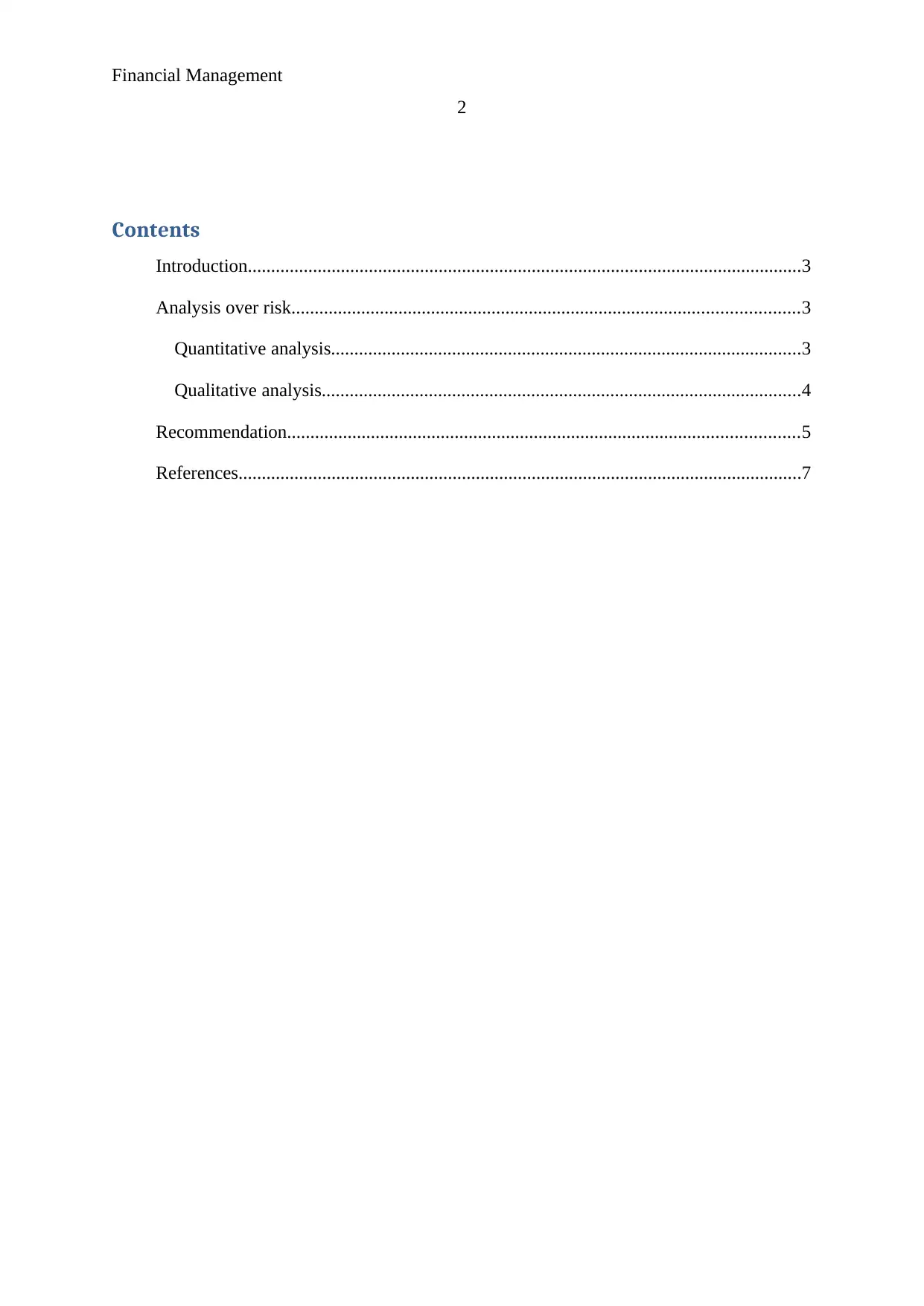
Financial Management
2
Contents
Introduction.......................................................................................................................3
Analysis over risk.............................................................................................................3
Quantitative analysis.....................................................................................................3
Qualitative analysis.......................................................................................................4
Recommendation..............................................................................................................5
References.........................................................................................................................7
2
Contents
Introduction.......................................................................................................................3
Analysis over risk.............................................................................................................3
Quantitative analysis.....................................................................................................3
Qualitative analysis.......................................................................................................4
Recommendation..............................................................................................................5
References.........................................................................................................................7
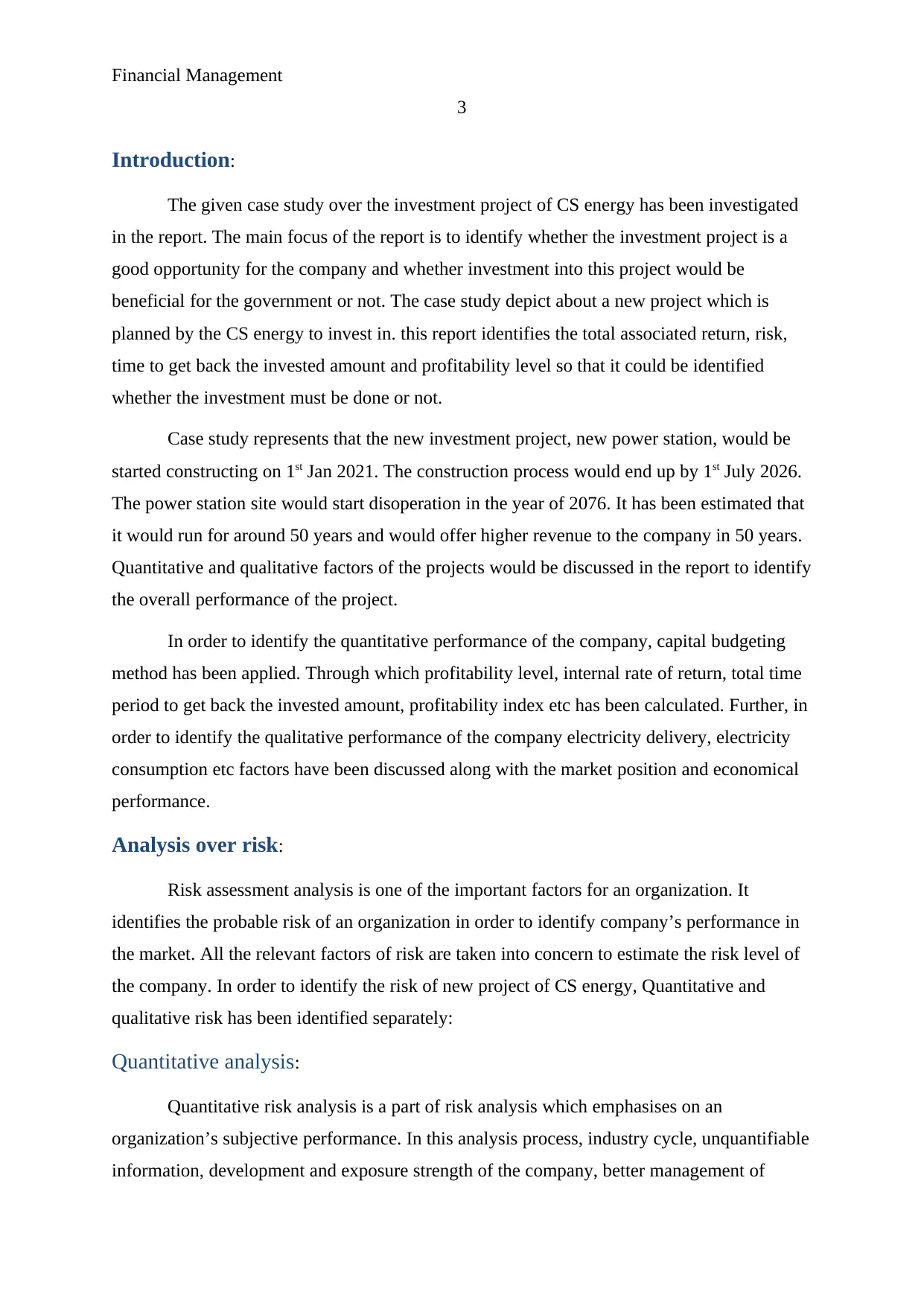
Financial Management
3
Introduction:
The given case study over the investment project of CS energy has been investigated
in the report. The main focus of the report is to identify whether the investment project is a
good opportunity for the company and whether investment into this project would be
beneficial for the government or not. The case study depict about a new project which is
planned by the CS energy to invest in. this report identifies the total associated return, risk,
time to get back the invested amount and profitability level so that it could be identified
whether the investment must be done or not.
Case study represents that the new investment project, new power station, would be
started constructing on 1st Jan 2021. The construction process would end up by 1st July 2026.
The power station site would start disoperation in the year of 2076. It has been estimated that
it would run for around 50 years and would offer higher revenue to the company in 50 years.
Quantitative and qualitative factors of the projects would be discussed in the report to identify
the overall performance of the project.
In order to identify the quantitative performance of the company, capital budgeting
method has been applied. Through which profitability level, internal rate of return, total time
period to get back the invested amount, profitability index etc has been calculated. Further, in
order to identify the qualitative performance of the company electricity delivery, electricity
consumption etc factors have been discussed along with the market position and economical
performance.
Analysis over risk:
Risk assessment analysis is one of the important factors for an organization. It
identifies the probable risk of an organization in order to identify company’s performance in
the market. All the relevant factors of risk are taken into concern to estimate the risk level of
the company. In order to identify the risk of new project of CS energy, Quantitative and
qualitative risk has been identified separately:
Quantitative analysis:
Quantitative risk analysis is a part of risk analysis which emphasises on an
organization’s subjective performance. In this analysis process, industry cycle, unquantifiable
information, development and exposure strength of the company, better management of
3
Introduction:
The given case study over the investment project of CS energy has been investigated
in the report. The main focus of the report is to identify whether the investment project is a
good opportunity for the company and whether investment into this project would be
beneficial for the government or not. The case study depict about a new project which is
planned by the CS energy to invest in. this report identifies the total associated return, risk,
time to get back the invested amount and profitability level so that it could be identified
whether the investment must be done or not.
Case study represents that the new investment project, new power station, would be
started constructing on 1st Jan 2021. The construction process would end up by 1st July 2026.
The power station site would start disoperation in the year of 2076. It has been estimated that
it would run for around 50 years and would offer higher revenue to the company in 50 years.
Quantitative and qualitative factors of the projects would be discussed in the report to identify
the overall performance of the project.
In order to identify the quantitative performance of the company, capital budgeting
method has been applied. Through which profitability level, internal rate of return, total time
period to get back the invested amount, profitability index etc has been calculated. Further, in
order to identify the qualitative performance of the company electricity delivery, electricity
consumption etc factors have been discussed along with the market position and economical
performance.
Analysis over risk:
Risk assessment analysis is one of the important factors for an organization. It
identifies the probable risk of an organization in order to identify company’s performance in
the market. All the relevant factors of risk are taken into concern to estimate the risk level of
the company. In order to identify the risk of new project of CS energy, Quantitative and
qualitative risk has been identified separately:
Quantitative analysis:
Quantitative risk analysis is a part of risk analysis which emphasises on an
organization’s subjective performance. In this analysis process, industry cycle, unquantifiable
information, development and exposure strength of the company, better management of
⊘ This is a preview!⊘
Do you want full access?
Subscribe today to unlock all pages.

Trusted by 1+ million students worldwide
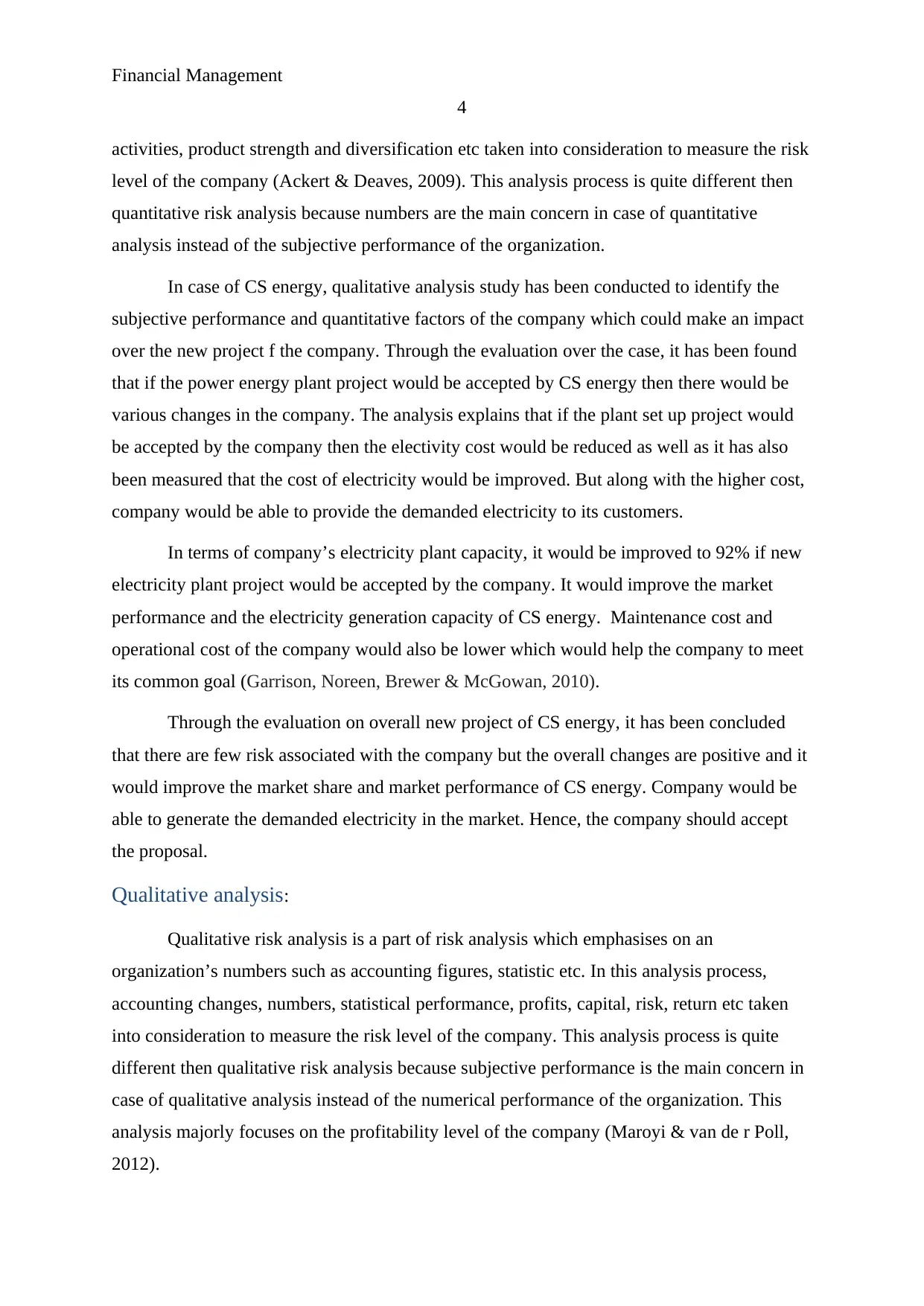
Financial Management
4
activities, product strength and diversification etc taken into consideration to measure the risk
level of the company (Ackert & Deaves, 2009). This analysis process is quite different then
quantitative risk analysis because numbers are the main concern in case of quantitative
analysis instead of the subjective performance of the organization.
In case of CS energy, qualitative analysis study has been conducted to identify the
subjective performance and quantitative factors of the company which could make an impact
over the new project f the company. Through the evaluation over the case, it has been found
that if the power energy plant project would be accepted by CS energy then there would be
various changes in the company. The analysis explains that if the plant set up project would
be accepted by the company then the electivity cost would be reduced as well as it has also
been measured that the cost of electricity would be improved. But along with the higher cost,
company would be able to provide the demanded electricity to its customers.
In terms of company’s electricity plant capacity, it would be improved to 92% if new
electricity plant project would be accepted by the company. It would improve the market
performance and the electricity generation capacity of CS energy. Maintenance cost and
operational cost of the company would also be lower which would help the company to meet
its common goal (Garrison, Noreen, Brewer & McGowan, 2010).
Through the evaluation on overall new project of CS energy, it has been concluded
that there are few risk associated with the company but the overall changes are positive and it
would improve the market share and market performance of CS energy. Company would be
able to generate the demanded electricity in the market. Hence, the company should accept
the proposal.
Qualitative analysis:
Qualitative risk analysis is a part of risk analysis which emphasises on an
organization’s numbers such as accounting figures, statistic etc. In this analysis process,
accounting changes, numbers, statistical performance, profits, capital, risk, return etc taken
into consideration to measure the risk level of the company. This analysis process is quite
different then qualitative risk analysis because subjective performance is the main concern in
case of qualitative analysis instead of the numerical performance of the organization. This
analysis majorly focuses on the profitability level of the company (Maroyi & van de r Poll,
2012).
4
activities, product strength and diversification etc taken into consideration to measure the risk
level of the company (Ackert & Deaves, 2009). This analysis process is quite different then
quantitative risk analysis because numbers are the main concern in case of quantitative
analysis instead of the subjective performance of the organization.
In case of CS energy, qualitative analysis study has been conducted to identify the
subjective performance and quantitative factors of the company which could make an impact
over the new project f the company. Through the evaluation over the case, it has been found
that if the power energy plant project would be accepted by CS energy then there would be
various changes in the company. The analysis explains that if the plant set up project would
be accepted by the company then the electivity cost would be reduced as well as it has also
been measured that the cost of electricity would be improved. But along with the higher cost,
company would be able to provide the demanded electricity to its customers.
In terms of company’s electricity plant capacity, it would be improved to 92% if new
electricity plant project would be accepted by the company. It would improve the market
performance and the electricity generation capacity of CS energy. Maintenance cost and
operational cost of the company would also be lower which would help the company to meet
its common goal (Garrison, Noreen, Brewer & McGowan, 2010).
Through the evaluation on overall new project of CS energy, it has been concluded
that there are few risk associated with the company but the overall changes are positive and it
would improve the market share and market performance of CS energy. Company would be
able to generate the demanded electricity in the market. Hence, the company should accept
the proposal.
Qualitative analysis:
Qualitative risk analysis is a part of risk analysis which emphasises on an
organization’s numbers such as accounting figures, statistic etc. In this analysis process,
accounting changes, numbers, statistical performance, profits, capital, risk, return etc taken
into consideration to measure the risk level of the company. This analysis process is quite
different then qualitative risk analysis because subjective performance is the main concern in
case of qualitative analysis instead of the numerical performance of the organization. This
analysis majorly focuses on the profitability level of the company (Maroyi & van de r Poll,
2012).
Paraphrase This Document
Need a fresh take? Get an instant paraphrase of this document with our AI Paraphraser
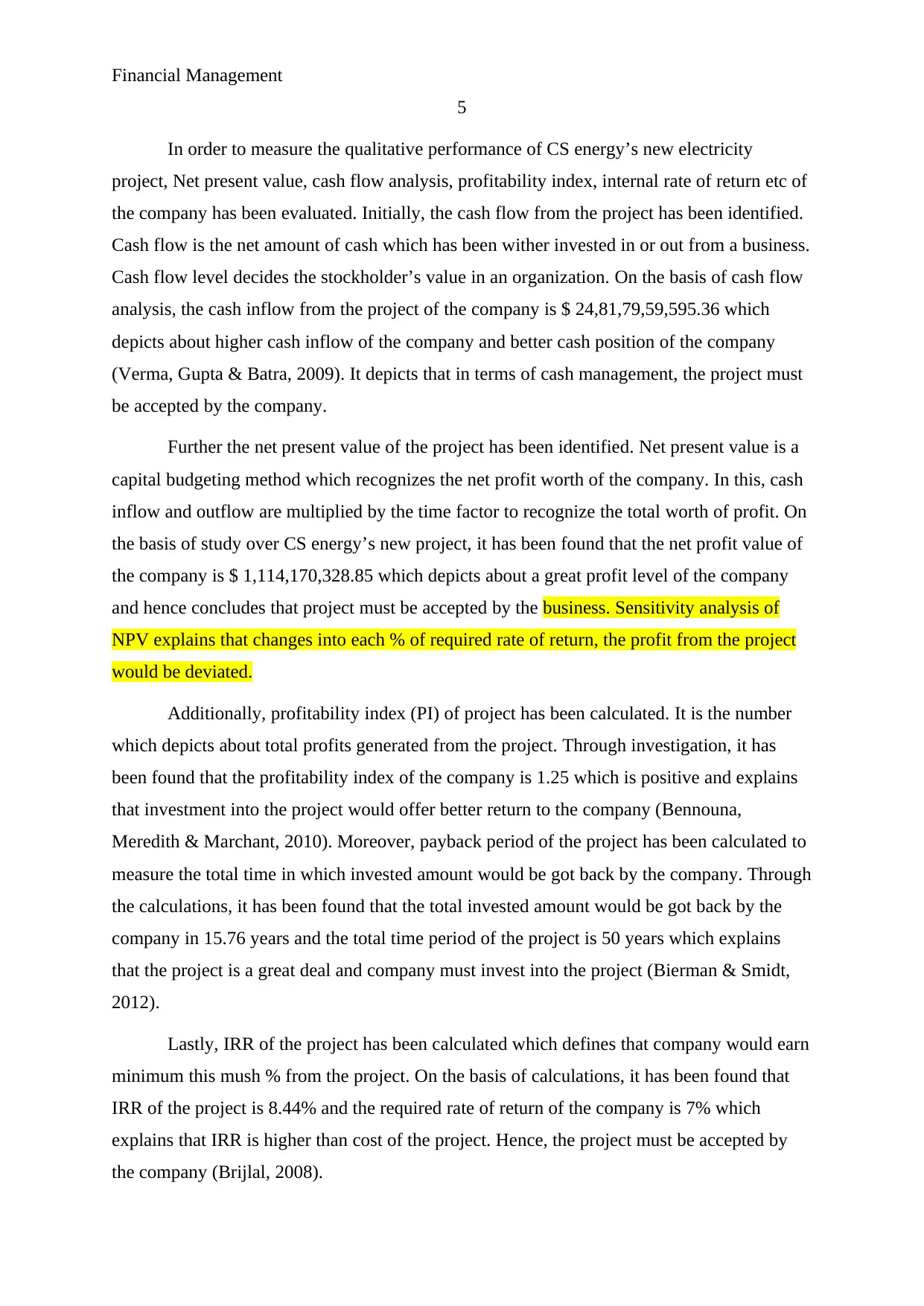
Financial Management
5
In order to measure the qualitative performance of CS energy’s new electricity
project, Net present value, cash flow analysis, profitability index, internal rate of return etc of
the company has been evaluated. Initially, the cash flow from the project has been identified.
Cash flow is the net amount of cash which has been wither invested in or out from a business.
Cash flow level decides the stockholder’s value in an organization. On the basis of cash flow
analysis, the cash inflow from the project of the company is $ 24,81,79,59,595.36 which
depicts about higher cash inflow of the company and better cash position of the company
(Verma, Gupta & Batra, 2009). It depicts that in terms of cash management, the project must
be accepted by the company.
Further the net present value of the project has been identified. Net present value is a
capital budgeting method which recognizes the net profit worth of the company. In this, cash
inflow and outflow are multiplied by the time factor to recognize the total worth of profit. On
the basis of study over CS energy’s new project, it has been found that the net profit value of
the company is $ 1,114,170,328.85 which depicts about a great profit level of the company
and hence concludes that project must be accepted by the business. Sensitivity analysis of
NPV explains that changes into each % of required rate of return, the profit from the project
would be deviated.
Additionally, profitability index (PI) of project has been calculated. It is the number
which depicts about total profits generated from the project. Through investigation, it has
been found that the profitability index of the company is 1.25 which is positive and explains
that investment into the project would offer better return to the company (Bennouna,
Meredith & Marchant, 2010). Moreover, payback period of the project has been calculated to
measure the total time in which invested amount would be got back by the company. Through
the calculations, it has been found that the total invested amount would be got back by the
company in 15.76 years and the total time period of the project is 50 years which explains
that the project is a great deal and company must invest into the project (Bierman & Smidt,
2012).
Lastly, IRR of the project has been calculated which defines that company would earn
minimum this mush % from the project. On the basis of calculations, it has been found that
IRR of the project is 8.44% and the required rate of return of the company is 7% which
explains that IRR is higher than cost of the project. Hence, the project must be accepted by
the company (Brijlal, 2008).
5
In order to measure the qualitative performance of CS energy’s new electricity
project, Net present value, cash flow analysis, profitability index, internal rate of return etc of
the company has been evaluated. Initially, the cash flow from the project has been identified.
Cash flow is the net amount of cash which has been wither invested in or out from a business.
Cash flow level decides the stockholder’s value in an organization. On the basis of cash flow
analysis, the cash inflow from the project of the company is $ 24,81,79,59,595.36 which
depicts about higher cash inflow of the company and better cash position of the company
(Verma, Gupta & Batra, 2009). It depicts that in terms of cash management, the project must
be accepted by the company.
Further the net present value of the project has been identified. Net present value is a
capital budgeting method which recognizes the net profit worth of the company. In this, cash
inflow and outflow are multiplied by the time factor to recognize the total worth of profit. On
the basis of study over CS energy’s new project, it has been found that the net profit value of
the company is $ 1,114,170,328.85 which depicts about a great profit level of the company
and hence concludes that project must be accepted by the business. Sensitivity analysis of
NPV explains that changes into each % of required rate of return, the profit from the project
would be deviated.
Additionally, profitability index (PI) of project has been calculated. It is the number
which depicts about total profits generated from the project. Through investigation, it has
been found that the profitability index of the company is 1.25 which is positive and explains
that investment into the project would offer better return to the company (Bennouna,
Meredith & Marchant, 2010). Moreover, payback period of the project has been calculated to
measure the total time in which invested amount would be got back by the company. Through
the calculations, it has been found that the total invested amount would be got back by the
company in 15.76 years and the total time period of the project is 50 years which explains
that the project is a great deal and company must invest into the project (Bierman & Smidt,
2012).
Lastly, IRR of the project has been calculated which defines that company would earn
minimum this mush % from the project. On the basis of calculations, it has been found that
IRR of the project is 8.44% and the required rate of return of the company is 7% which
explains that IRR is higher than cost of the project. Hence, the project must be accepted by
the company (Brijlal, 2008).
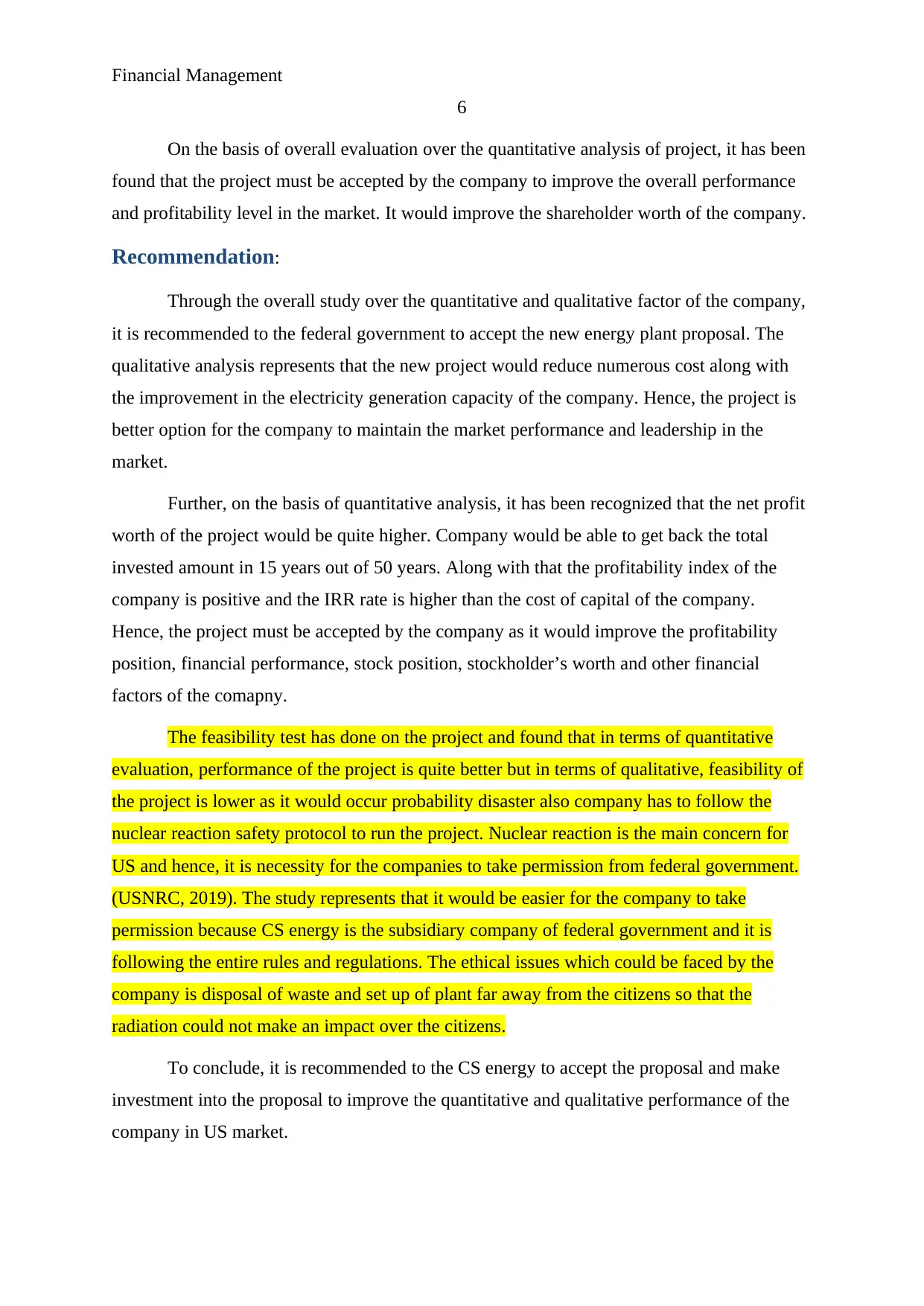
Financial Management
6
On the basis of overall evaluation over the quantitative analysis of project, it has been
found that the project must be accepted by the company to improve the overall performance
and profitability level in the market. It would improve the shareholder worth of the company.
Recommendation:
Through the overall study over the quantitative and qualitative factor of the company,
it is recommended to the federal government to accept the new energy plant proposal. The
qualitative analysis represents that the new project would reduce numerous cost along with
the improvement in the electricity generation capacity of the company. Hence, the project is
better option for the company to maintain the market performance and leadership in the
market.
Further, on the basis of quantitative analysis, it has been recognized that the net profit
worth of the project would be quite higher. Company would be able to get back the total
invested amount in 15 years out of 50 years. Along with that the profitability index of the
company is positive and the IRR rate is higher than the cost of capital of the company.
Hence, the project must be accepted by the company as it would improve the profitability
position, financial performance, stock position, stockholder’s worth and other financial
factors of the comapny.
The feasibility test has done on the project and found that in terms of quantitative
evaluation, performance of the project is quite better but in terms of qualitative, feasibility of
the project is lower as it would occur probability disaster also company has to follow the
nuclear reaction safety protocol to run the project. Nuclear reaction is the main concern for
US and hence, it is necessity for the companies to take permission from federal government.
(USNRC, 2019). The study represents that it would be easier for the company to take
permission because CS energy is the subsidiary company of federal government and it is
following the entire rules and regulations. The ethical issues which could be faced by the
company is disposal of waste and set up of plant far away from the citizens so that the
radiation could not make an impact over the citizens.
To conclude, it is recommended to the CS energy to accept the proposal and make
investment into the proposal to improve the quantitative and qualitative performance of the
company in US market.
6
On the basis of overall evaluation over the quantitative analysis of project, it has been
found that the project must be accepted by the company to improve the overall performance
and profitability level in the market. It would improve the shareholder worth of the company.
Recommendation:
Through the overall study over the quantitative and qualitative factor of the company,
it is recommended to the federal government to accept the new energy plant proposal. The
qualitative analysis represents that the new project would reduce numerous cost along with
the improvement in the electricity generation capacity of the company. Hence, the project is
better option for the company to maintain the market performance and leadership in the
market.
Further, on the basis of quantitative analysis, it has been recognized that the net profit
worth of the project would be quite higher. Company would be able to get back the total
invested amount in 15 years out of 50 years. Along with that the profitability index of the
company is positive and the IRR rate is higher than the cost of capital of the company.
Hence, the project must be accepted by the company as it would improve the profitability
position, financial performance, stock position, stockholder’s worth and other financial
factors of the comapny.
The feasibility test has done on the project and found that in terms of quantitative
evaluation, performance of the project is quite better but in terms of qualitative, feasibility of
the project is lower as it would occur probability disaster also company has to follow the
nuclear reaction safety protocol to run the project. Nuclear reaction is the main concern for
US and hence, it is necessity for the companies to take permission from federal government.
(USNRC, 2019). The study represents that it would be easier for the company to take
permission because CS energy is the subsidiary company of federal government and it is
following the entire rules and regulations. The ethical issues which could be faced by the
company is disposal of waste and set up of plant far away from the citizens so that the
radiation could not make an impact over the citizens.
To conclude, it is recommended to the CS energy to accept the proposal and make
investment into the proposal to improve the quantitative and qualitative performance of the
company in US market.
⊘ This is a preview!⊘
Do you want full access?
Subscribe today to unlock all pages.

Trusted by 1+ million students worldwide
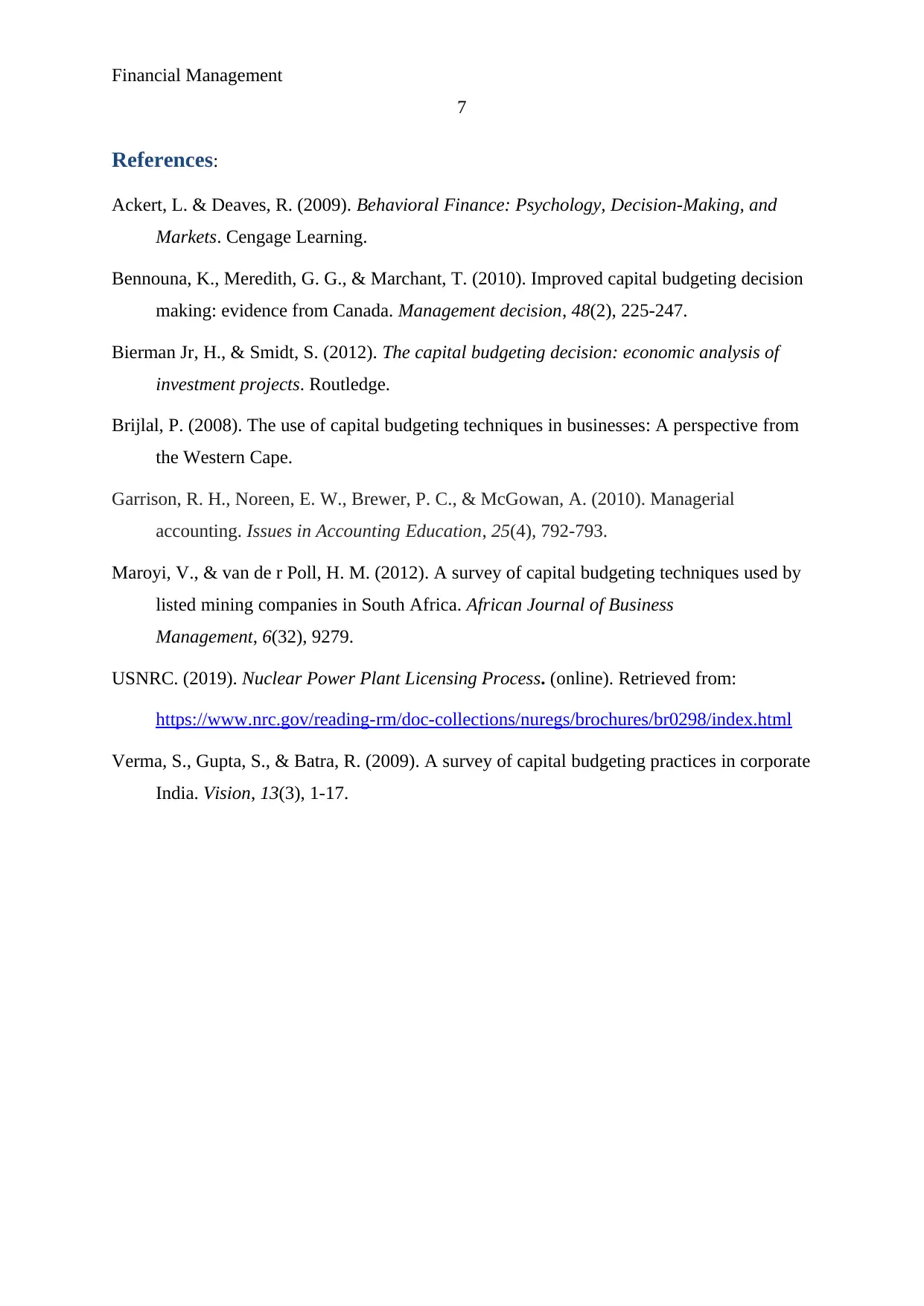
Financial Management
7
References:
Ackert, L. & Deaves, R. (2009). Behavioral Finance: Psychology, Decision-Making, and
Markets. Cengage Learning.
Bennouna, K., Meredith, G. G., & Marchant, T. (2010). Improved capital budgeting decision
making: evidence from Canada. Management decision, 48(2), 225-247.
Bierman Jr, H., & Smidt, S. (2012). The capital budgeting decision: economic analysis of
investment projects. Routledge.
Brijlal, P. (2008). The use of capital budgeting techniques in businesses: A perspective from
the Western Cape.
Garrison, R. H., Noreen, E. W., Brewer, P. C., & McGowan, A. (2010). Managerial
accounting. Issues in Accounting Education, 25(4), 792-793.
Maroyi, V., & van de r Poll, H. M. (2012). A survey of capital budgeting techniques used by
listed mining companies in South Africa. African Journal of Business
Management, 6(32), 9279.
USNRC. (2019). Nuclear Power Plant Licensing Process. (online). Retrieved from:
https://www.nrc.gov/reading-rm/doc-collections/nuregs/brochures/br0298/index.html
Verma, S., Gupta, S., & Batra, R. (2009). A survey of capital budgeting practices in corporate
India. Vision, 13(3), 1-17.
7
References:
Ackert, L. & Deaves, R. (2009). Behavioral Finance: Psychology, Decision-Making, and
Markets. Cengage Learning.
Bennouna, K., Meredith, G. G., & Marchant, T. (2010). Improved capital budgeting decision
making: evidence from Canada. Management decision, 48(2), 225-247.
Bierman Jr, H., & Smidt, S. (2012). The capital budgeting decision: economic analysis of
investment projects. Routledge.
Brijlal, P. (2008). The use of capital budgeting techniques in businesses: A perspective from
the Western Cape.
Garrison, R. H., Noreen, E. W., Brewer, P. C., & McGowan, A. (2010). Managerial
accounting. Issues in Accounting Education, 25(4), 792-793.
Maroyi, V., & van de r Poll, H. M. (2012). A survey of capital budgeting techniques used by
listed mining companies in South Africa. African Journal of Business
Management, 6(32), 9279.
USNRC. (2019). Nuclear Power Plant Licensing Process. (online). Retrieved from:
https://www.nrc.gov/reading-rm/doc-collections/nuregs/brochures/br0298/index.html
Verma, S., Gupta, S., & Batra, R. (2009). A survey of capital budgeting practices in corporate
India. Vision, 13(3), 1-17.
1 out of 7
Related Documents
Your All-in-One AI-Powered Toolkit for Academic Success.
+13062052269
info@desklib.com
Available 24*7 on WhatsApp / Email
![[object Object]](/_next/static/media/star-bottom.7253800d.svg)
Unlock your academic potential
Copyright © 2020–2025 A2Z Services. All Rights Reserved. Developed and managed by ZUCOL.





